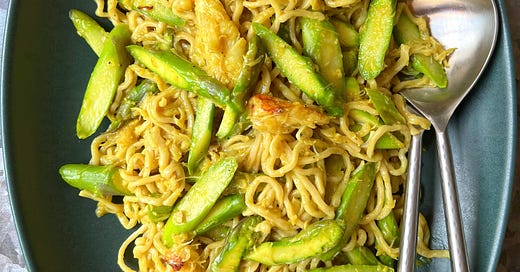Vietnamese Garlic Noodles 3.0, Crab-Asparagus recipe
+ Epiphanies in the kitchen + garlic sprout removal? + fresh Chinese noodles
You heard a lot from me this past week. That’s abnormal but yesterday, I was so surprised by this garlic noodle recipe that I didn’t know how to immediately tell folks (aside from my husband) so I put it out in Notes. If you’re into staying in the loop a little more, try Notes. If not, keep our relationship in your inbox.
On Thursday, 4/20, I’m being interviewed by Viet Thanh Nguyen, the Pulitzer prize-winning novelist of The Sympathizer. He has a YouTube show called Accent. Attend for FREE! Register for the Zoom link.
PTFS is over 10,000 subscribers strong and over 200 people are generously supporting this project through paid subscriptions. Thank you! I never thought we’d be at such numbers and growing so well. This post completes the Vietnamese Garlic Noodle trilogy, with a boffo recipe for paid subscribers.
Where do you have cooking epiphanies? Mine used to happen in the shower but after the 2020 kitchen renovation, I finally had a calm lab/workspace. I designed the kitchen to help me get into my creative cooking zone and clean efficiently. Some novelists have writing sheds, I have my kitchen (and shower).
Standing at the counter prepping the garlic black pepper crab, I wondered if I could improve my umami garlic-shiitake noodle recipe with a garlic-shallot-turmeric seasoning paste that’s similar to the base of the crab dish. I wanted the sweetness of slightly caramelized shallot to add to that of the pungent nutty garlic. I also wanted to replace the mushroom with leafy greens to amp up the fiber and cut back on the carbs.
I cooked on a hunch and for flair, I put the crab on top. My husband’s reaction: “The crab is messy good but the noodles are fantastic.”
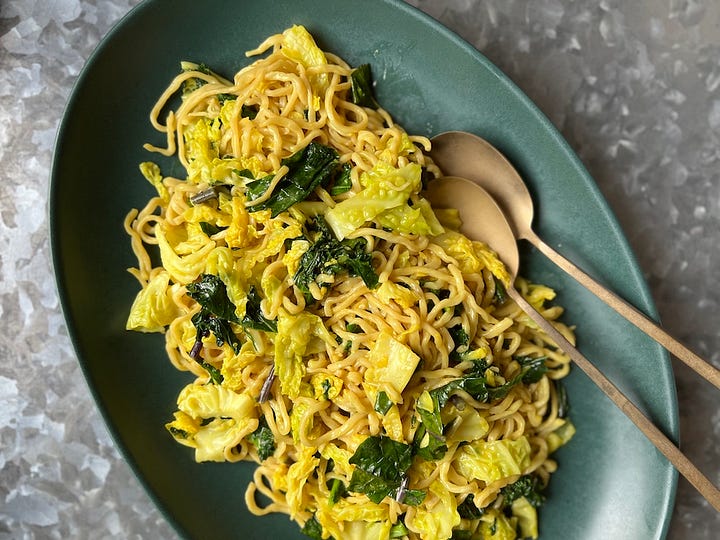
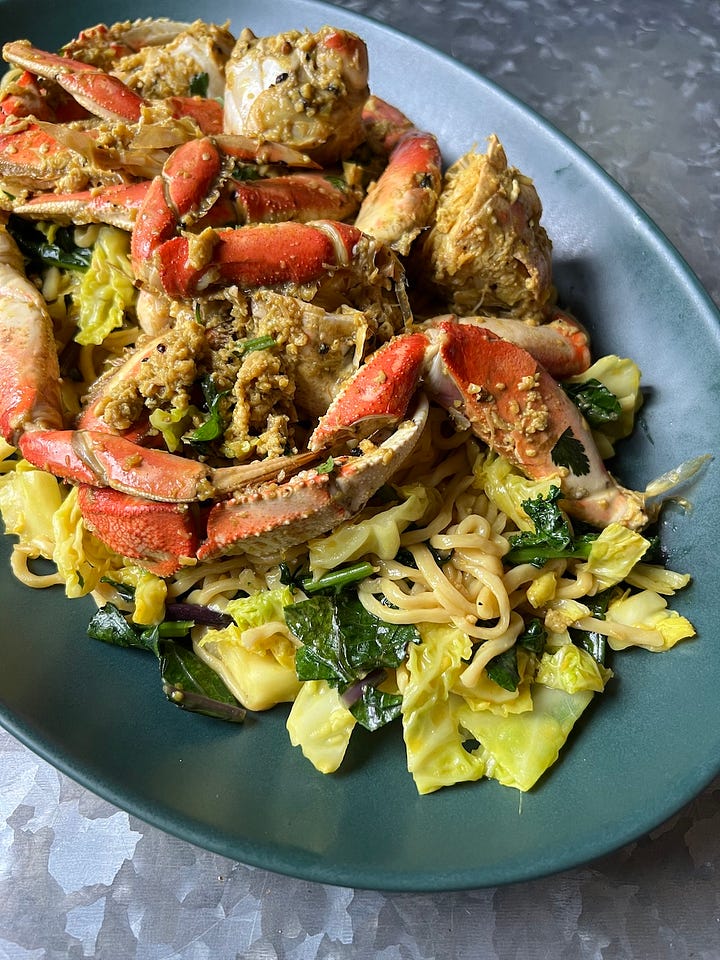
You’re looking at savoy cabbage and kale in the noodles. They added textural contrast. The turmeric further awakened the dish with color. I’d mentioned in the last post about how garlic noodles aren’t great looking, despite their deliciousness. There was promise in this third iteration.
Garlic Removal Reversal?
As I let the recipe simmer on my brain’s back burner, on Twitter, Rob alerted me to a recent America’s Test Kitchen epiphany about removing the sprout from garlic. They wrote that the grassy sprout is not to blame. The bitterness comes from the rest of the clove, which dries out as it gives up sugars to grow its sprout. In its drier, sprouted state, the garlic can cook up harsh, especially in “big” garlic dishes. ATK’s upshot:
If your garlic has sprouts, don't bother taking them out. And for more mellow, well-rounded garlic flavor in dishes that are garlic-forward, try to use cloves that haven't yet sprouted.
Thinking back on the umami garlic shiitake noodles post and my Italian friend’s tip about hydrating garlic, perhaps he had meant to deal with sprouted garlic?
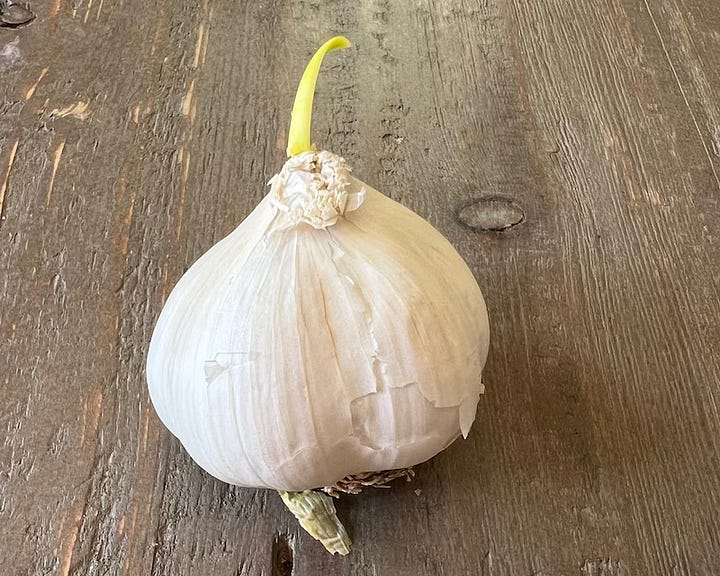
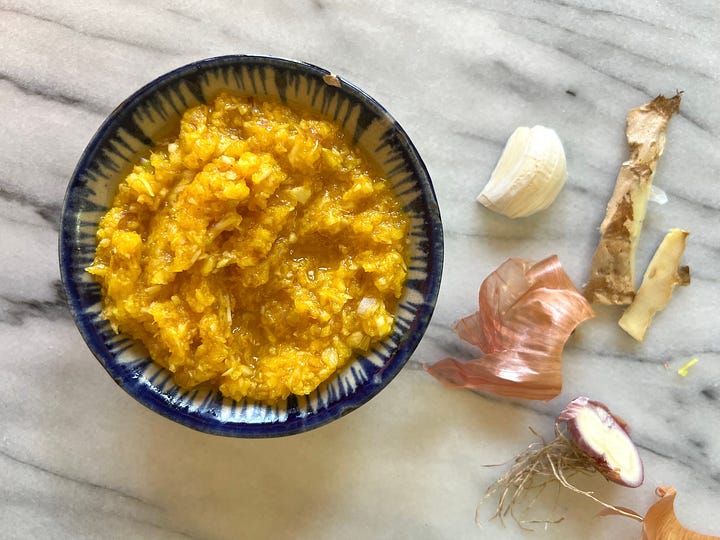
In making the paste for this crab iteration of Vietnamese garlic noodles, I kept the sprout. The garlic noodles were fabulous. No harsh garlic flavor. I suspect that in this recipe, the shallot, ginger and water mollified any garlic harshness.
Garlic noodles is a garlic heavy dish but going the paste route didn’t necessitate sprout removal! However, you may want to remove the sprout in other very garlicky instances.
Fresh Chinese Noodle Tips
For this final recipe, I went all in with fresh Chinese noodles because they are tender-springy, just the right soft-chewy texture to absorb the seasonings and have the cozy feel of Asian noodle-ness. In the main, Asian noodles are made of a softer wheat than Italian pasta. You could prepare garlic noodles with pasta but my best Vietnamese garlic noodles employed fresh Chinese noodles.
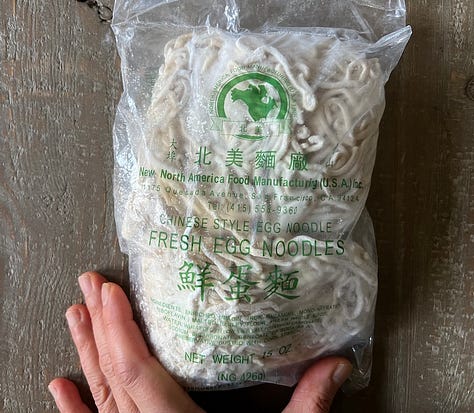
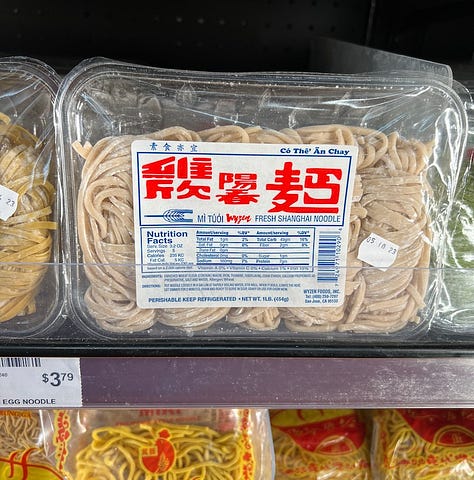


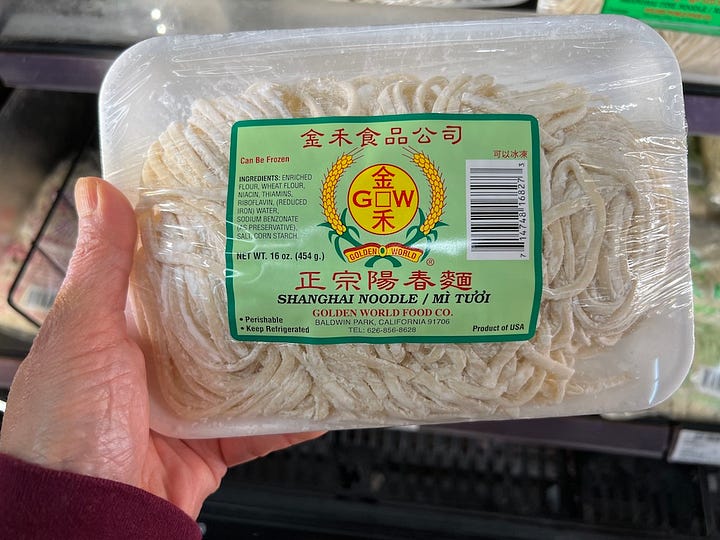
At a Chinese market in the refrigerated section near dumpling wrappers and tofu, look for medium width noodles made of wheat. (Think of what you use for chow mein or pan-fried noodles.) They may be labeled “Egg Noodle” but are commonly called “Shanghai Noodle.” I used the ones in the upper left corner. They’re made in the Bay Area and stocked at many local Chinese markets. Use what your local Asian market carries. The other brands are from a Ranch 99 in Southern California. Twin Marquis is nationally distributed and very good.
Anyone know what Shanghai noodles are? I’m unclear. When I was in Shanghai years ago, I saw noodles of different thicknesses. There’s a Wikipedia entry on it with a recommendation to sub udon noodles. Don’t do that. If I had to go with dried noodles, I’d select Quon Yick brand, which is excellent and from California.
Garlic x Crab x Asparagus = Seasonal Garlic Noodles
When I went to remake the garlic noodles with leafy greens, I paused and switched gears to an asparagus and crab ditty. We’re getting local asparagus and I had crab meat in the freezer! Leafy greens are available year round. I wanted to celebrate the season. The crab was a workaround for a less messy version of eating black pepper crab alongside the noodles. The resulting Garlic-Crab-Asparagus Noodles was divine. Garlicky yet elegant and elevated because of the crab and asparagus. It tasted like a fancy, pricey dish.
Fresh (unfrozen) crab would have been less shreddy. You could opt out of the crab and still have a splendid dish. Consider surimi if that suits your wallet and palate. The recipe below includes a vegetarian workaround too. A quick note on how I built a crablike flavor hit before you go for it!


